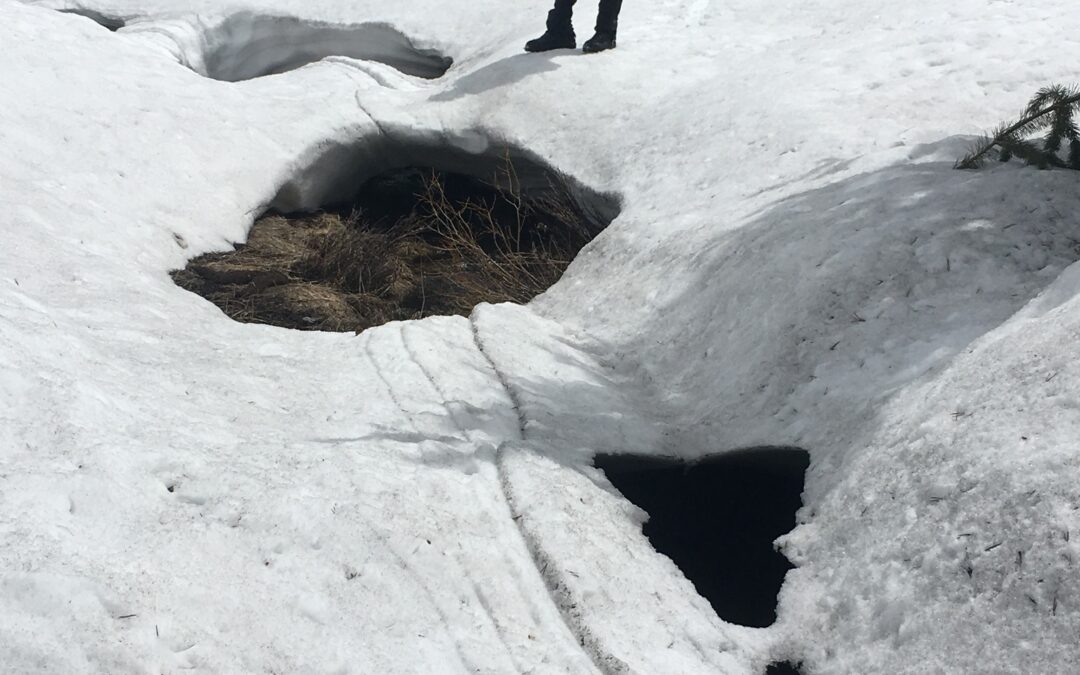What makes snow, in and of itself, so dangerous to snow-hikers?
- It is obviously cold (it’s frozen water). The more of yourself you expose to it, the colder you get, leading to hypothermia and death, at the worst, and frostbite (localized soft tissue necrosis) and frostnip, at the least.
- It’s wet. Moisture on the skin is evaporated by the body’s core temp of 98.6 degrees causing a loss of internal heat. This heat loss can be seriously accelerated by the movement of wind over the skin further decreasing the skin’s temperature and increasing the loss of core heat. Not good.
- It can be compressed. If you step on its soft form, called “powder snow,” it will compress easily and not hold your weight. Even wearing snowshoes that increase your “flotation” over snow, walking on powder snow can be exhausting after even a mile’s travel of high-stepping and lifting of snow-ladened snowshoes. In its soft, wet, and melting form commonly seen during the Sierra Thaw, it can easily be compressed and won’t hold your weight, either, causing “postholing” of each attempted step on its surface and agonizing “wallowing” through it that just gets you further cold and wet.
- It can melt and freeze hard and solid. Once the sun comes out after a snowstorm, it begins to melt the little flakes of snow and they shrink down and stick together into a wet mess which settles and re-freezes at night during the winter months until the Thaw begins when it remains this soft, wet mess all day long, melting down into nearby creeks and flowing downhill to the sea (wow! Long sentence!). When frozen, it can be exceedingly slippery to most rubber shoes causing slip-and-falls ensuing in out-of-control tumbles down mountainsides to, usually, injury. To continue to walk on its frozen surface, metal, traction aids, like Microspikes or hiking-crampons, must be deployed to prevent slipping.
- It covers everything. Little and big objects get covered, like sticks, boulders, creeks, lakes, but so does the trail, making following it a challenge or impossible. Snow-hikers frequently get lost in this very cold and wet environment, if they don’t know how to safely navigate over snow with aids, like topographic maps, GPS units, and a compass.
- It can move. When loose or very wet and heavy snow sits on a mountainside steep enough to make a great sledding hill, under the right conditions, both within itself and in the environment outside it, snow can “unstick” from its own layerings and anchoring objects within it, release in one, big mass, and start sliding down the hill knocking over everything in its path, from people to huge trees.
- During the winter, new powder snow doesn’t “stick” very well to an old snowpack’s crusty surface, so, if the slope upon which it falls is steep enough, that loose powder snow will slide downhill right away. This is your classic powder-snow avalanche that can travel at freeway speeds and bury you under feet of snow.
- During the springtime Thaw, sun-melted snow that has turned into water gets reabsorbed by the snowpack, below it, making it unstable and heavy enough to break its bonds within its own layers and slide, again, but this time the ensuing mass moves slow and doesn’t typically travel very far. These are called “sloughs” of snow and are not commonly found near the PCT, but snow-hikers need to watch out for them, nevertheless.
- It can hide dangers within itself. The snowpack, however thick, is not composed of just soft or consolidated snow. After a snowstorm, the sun comes out and melts the surface of the powder that, later, gets re-frozen overnight resulting in a crusty surface to walk on. It’s not “glare ice,” but just wet snow that has frozen hard enough to, often, hold a hiker’s weight.
- Next, a new storm event comes along and dumps more powder snow on this old, crust layer, the sun comes out, thereafter, and melts another crust layer. So, every snowpack is composed of varying thickness of soft and frozen snow. If you were to dig into it, these layers become plain to see.
- When you posthole into the snowpack during the Thaw, it is common for your leg to scrape through and past many layers of frozen crust within the pack causing cuts and other injuries.
- Storms don’t just bring falling snow, but strong winds, as well, which blow branches off trees that get buried in the snowpack. When you posthole or while self-arresting, you can hit these objects within the pack and get hurt or worse.
- Obviously, new snowfall buries everything, like boulders, trees, logs, and bushes, which lie in wait to trip hiker’s feet or cut-up their legs during a posthole event.
Creeks and lakes get buried, too!
Sierra lakes get covered with 3-4 feet of a water-soaked snow mass that, when frozen overnight, is quite able to hold your weight, but know the signs of an unstable and softening, springtime snow-cover to a lake that, when identified, tell you to not go out on it!
Sierra creeks get covered, too, with many feet of consolidated and firm snow (a “snow bridge”) that allows you to walk right over them without a problem. Sometimes you can’t even tell if the summertime creek is even there! However, these buried creeks become quite dangerous during the Thaw when their thick covers thin-out and can’t hold your weight, anymore. Know the signs of an unstable and softening, springtime snow-cover to a creek and, if identified, you should not walk over on it!
These are the common dangers of Sierra snow-travel that every snow-hiker should be aware of and looking for to maintain their safety in the otherwise incredibly fun and exhilarating snowy environment encountered by thru-hikers of the Pacific Crest Trail.

